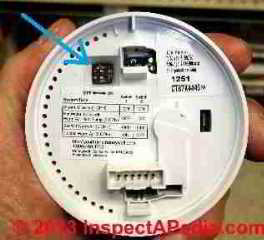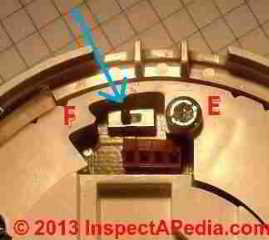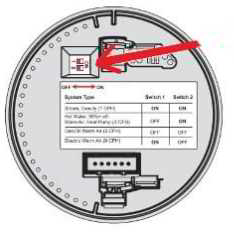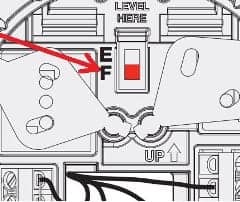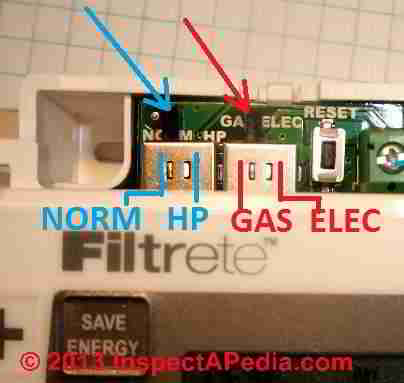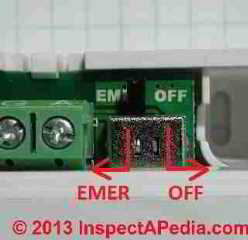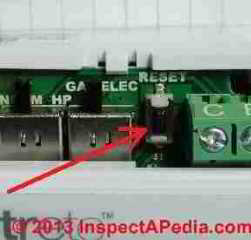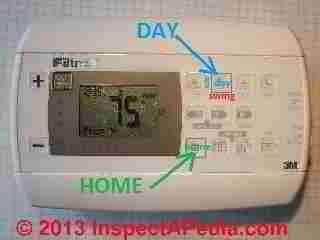 Thermostat Internal or Hidden Switch Settings
Thermostat Internal or Hidden Switch Settings
Set Thermostat Cycle Rate Switches, Fan Switches, Emergency Backup Heat, Reset, & other
switches inside of room thermostats
- POST a QUESTION or COMMENT about how & when to set the internal dip or slide switches inside the room thermostat
This article describes the purpose and setting of tiny switches found inside of some room thermostats. These little slide or toggle switches may control the heating system on-off cycle rate or burner-on time in a manner similar to the heat anticipator feature found in other room thermostats.
Here we describe various types of internal or "hidden" switches found in some wall thermostats and in a table form we summarize their proper setting.
In most cases you can safely install a new room thermostat without worrying about these switches - just leave the switch or switches in the factory-set position. But in some circumstances setting the switches correctly may involve a change .
InspectAPedia tolerates no conflicts of interest. We have no relationship with advertisers, products, or services discussed at this website.
- Daniel Friedman, Publisher/Editor/Author - See WHO ARE WE?
How to Set the Cycle Rate or Fan Operation Switches on a Room Thermostat
Here we describe various types of internal or "hidden" switches found in some wall thermostats and in a table form we summarize their proper setting. In most cases you can safely install a new room thermostat without worrying about these switches - just leave the switch or switches in the factory-set position.
But in some circumstances setting the switches correctly may involve a change .
...
...
...
How to Set the Internal Switches & Fan Control in a Honeywell CT87K Thermostat |
||||
| Heating System Type - Internal Cycle Rate Switches | Internal Cycle Rate Switches |
|||
| Switch 1 Position | Switch 2 Position | |||
Steam Heat:
|
ON |
ON |
||
| High Efficiency (90% or more) warm air (furnace) | OFF |
ON |
||
| Gas or Oil fired warm air (furnace) [Conventional furnaces - this is the factory setting] | OFF |
OFF |
||
| Electric warm air (furnace) | ON |
OFF |
||
| Heating System Type - Internal Fan Control Switch | Internal Fan Control Switch | |||
| Gas or oil fired heating systems [this is the factory setting] | F |
|||
| Electric or heat pump system Note 1 | E |
|||
Notes to the table above
1. This setting is for systems that allow the thermostat to control the fan in a call for heat, if a fan wire is connected to the G terminal.
2. Thanks to reader Fred Gruber for asking about switch settings in the CT87K, 6 March 2016. Fred asked:
Please just tell me which settings give the longest cycle on the CT87K.
Reply:
Fred, There is no traditional heat-anticipator adjustment as was found on some older thermostats we describe in this article series. We should simply follow Honeywell's recommendations for the CT 87K thermostat
In the CT87 owner's manual given below you'll see that the CT87N is for 24 Vac heating and cooling systems while the CT87K is for 24 Vac heating systems - that is the N model controls both heating and air conditioning.
[Thanks to InspectApedia.com Paul for correcting our mix-up on which thermostat is which, 29 Nov. 2019]
See THERMOSTAT INSTALLATION & WIRING MANUALS
3. Illustration and table above adapted from Honeywell's CT87 Owner's manual cited here: Source: Honeywell Owner's Manual, CT87N / CT87K Round Thermostat, [PDF] Honeywell International, Inc., 1985 Douglas Drive North, Golden Valley MN, 55422 or in Canada: 35 Dynamic Drive, Toronto, Ontario M1V 4Z9, Canada, Website: http://yourhome.honeywell.com retrieved 2016/03/06.
...
...
...
How to Change the Temperature Readout Calibration on a Programmable Thermostat
|
||||
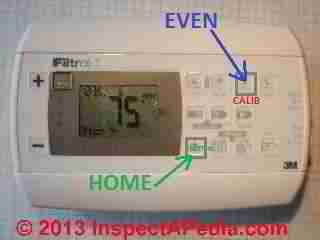 |
Thermostat temperature display calibration Thermostat engineers showing off or gone wild |
Factory | Range | |
The 3M Filtrete 3M-22 thermostat also provides an optional adjustment to its temperature readout described as "calibration". The thermostat is factory calibrated to an accuracy of +/- 1o F but users can deliberately change the temperature display readout to be "off-calibration" by +/- 6o F. The 3M-22 operating guide suggests you might want to do this to make the thermostat "agree" with another in the building or "agree" with the old thermostat that it is replacing - reasons that we consider ... well, frivolous. Imagine the confusion down the road when the next user goes crazy fiddling with the thermostat because it's "off" in temperature reading. There might be a more subtle reason that you'd deliberately change the temperature readout to an inaccurate number, following thinking similar to changing the swing cycle discussed just above. If the temperatures for the area being controlled by this thermostat always overshoot substantially past the thermostat's set point - something that might happen if the heat is provided by heavy cast iron radiators or baseboard - you could fudge the system by telling the thermostat that the room is warmer than it is. Similarly if a bad thermostat mounting location means it turns off the heat while the space is still too cold you might be tempted to fudge the calibration rather than moving the thermostat. Frankly we think changing the calibration on a thermostat is usually asking for trouble and confusion. Leave the calibration where it was set by the factory. As we explain at THERMISTORS this thermostat is capable of very good accuracy.If your building temperatures overshoot, try adjusting the swing cycle discussed just above rather than messing with the thermostat's calibration. |
+/- 1o F |
+/- 6o F |
||
Notes to the table above
These examples will not necessarily fit other brands or models of room thermostats. Consult the installation and operating instructions for your individual thermostat. Contact us by email if you are unable to find instructions for your room thermostat.
...
Reader Comments, Questions & Answers About The Article Above
Below you will find questions and answers previously posted on this page at its page bottom reader comment box.
Reader Q&A - also see RECOMMENDED ARTICLES & FAQs
On 2023-02-24 by InspectApedia Editor - On typical residential furnace controls you don't and can't adjust the run time as if there were a timer or clock
@charlie,
In case you don't have your copy, please see the Owners Guide for your thermostat here
HONEYWELL CT3200 THERMOSTAT OWNERS GUIDE
Check the FAQs section towards the end of the owners guide for some possible steps to try. Specifically note:
~ Furnace cycles too often or system cycle length is too short or too long
~ Heating does not come on
If you're still having trouble, contact Honeywell support directly for assistance. Their contact info is:
CUSTOMER ASSISTANCE
www.honeywell.com/yourhome
Call Honeywell Customer Care at 1-800-468-1502.
Before you call, please have the following information available:
— Thermostat model number and serial code (located under the battery cover).
— Type of heating/cooling system (hot water, warm air, oil, gas, etc.).
— Number of wires connected to the thermostat.
On typical residential furnace controls you don't and can't adjust the run time as if there were a timer or clock.
Instead, the on and off cycling of the blower fan is controlled by the thermostat.
As long as the thermostat is calling for heat the fan will run and the burner may turn on and off depending on the temperature in the furnace itself .
So if you're not getting the heat that you want you may want to look at the air flow and start by being sure that the ducts are not crimped or disconnected and that you have a clean air filter installed.
On 2023-02-23 by charlie
I'm using the Honeywell CT3200 wall thermostat to control a gas furnace, the heat system runned for four minutes & stop wait another 22 minutes to restart again, how can I adjust the running time for about 10 minutes and retuning time ?
On 2022-09-23 by InspectApedia-911 (mod) - how do I adjust the “swing” setting on Honeywell RTH2300 wall thermostat
@Bob B,
In programming mode, Advanced function number 5 allows you to specify the type of heating system that you have such as gas or oil and hot air or hot water. Those adjustments have some effect on what you are calling the swing setting.
If you don't have the instruction manual for your thermostat you can find it at
THERMOSTAT INSTALLATION & WIRING MANUALS
where you will find free PDF download files of instructions for just about every thermostat including yours.
On 2022-09-23 by Bob B
Hi
I’m using the Honeywell RTH2300 wall thermostat to control a gas furnace.
Is there a way to adjust the “swing” setting on this particular thermostat?
Thanks
On 2022-03-28 by Inspectapedia Com Moderator
@jerry slayton,
Possibly the thermostat is defective or there's a loose connection but before going further I'd like clarification.
Are you saying you turn your thermostat down to 64, turn it down to 40, or turn it "off" ?
Or are you saying you set the temperature back down to 64 from some higher number but then the thermostat never calls for heat and the house temperature drops down to 40?
On 2022-03-28 by jerry slayton
our ct87k turned off at 64 degrees when bed time.in night 40 degrees but it doesn't turn on again.?
On 2022-03-25 by Inspectapedia Com Moderator - problems with burning up the low voltage transformer
@Gary,
When I've found problems with burning up the low voltage transformer usually the issue has been tracked to
- shorted thermostat or control wires
- overloading the transformer (too many devices being supported)
- an under-sized transformer
Honeywell also warns that the CT87K is not the right replacement for every situation (If your HVAC system thermostat was using 4 or more wires you need a different model)
You probably already have it but if not the IO and Wiring manuals for your Honeywell CT87K are at
THERMOSTAT WIRING HONEYWELL
and for your White Rodgers 1311 zone valve the IO manual is listed as a PDF download at
ZONE VALVE MANUALS & WIRING
On 2022-03-24 by Gary
I replaced Honeywell mercury stat with Honeywell ct87k... Cycle rate set switch 1 off.. 2 on.. runs couple days blows 24 transformer in boiler.. when that happens zone valve runs continually. Has new white Rodgers 1311-102 valve...
On 2021-07-13 by danjoefriedman (mod) - set the thermostat switch according to your actual heating method
@Oscar,
How is your building heated?
Electric heat, or a fossil fuel like gas or oil, or by a heat pump?
You'd set the thermostat switch according to your actual heating method.
Don't worry too much about this setting: your thermostat will work in any event, but its accuracy in choosing exactly how to turn your heating system off will be improved if the switch is set correctly.
Let me know if this answers your question or post follow up questions if you like.
On 2021-07-13 by Oscar
The switch in the back of my thermostat what's recommended to leave on gas or oil or Electric or heat pump.
On 2021-04-05 by danjoefriedman (mod)
@Bob,
I'm resisting the temptation to make up an answer when I'm not sure I understand the question. Are you talking about monitoring a home against freeze Risk by keeping an eye on its temperature independent of the thermostat setting? Where are you talking about a setting on the thermostat itself in which case I'm not sure of your use of the word monitoring?
On 2021-04-05 by Bob
I need to know what setting to have my thermostat monitor on as I have a natural gas furnace
On 2021-01-18 by danjoefriedman (mod)
Debbie,
Not every thermostat has internal switches that you need to change. So we need to start with the brand and model of your specific thermostats to know what switches it includes. You shouldn't need to turn any internal switch on or off simply to have heat.
On 2021-01-17 by Debbie
how do we turn on switch to on and off
On 2020-12-06 - by (mod) -
Although it won't make a big difference I agree that if you have oil fueled heat than you would set the switch to oil.
On 2020-12-06 by Jeremy
I wonder if it was set to electric because we have forced air to and in the winter it needs to be switched?
So if i have a fuel oil forced air furnace the tab on the back should be slid over to gas /oil? We bought the house and it was set on electric
On 2020-05-26 - by (mod) -
Anon
See our extensive diagnostics for an air conditioner that won't run, beginning at
AIR CONDITIONER WON'T START
On 2020-05-25 by Anonymous
My aircondition wont turn on
On 2019-12-12 - by (mod) -
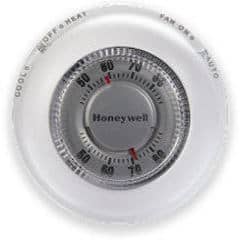 Paul
Paul
Thank you so much for important comment clarify which thermostat models provide which functions. I always start by trusting honeywell's documentation as the most accurate. I'll review our article with that in mind. Thank you for taking the time to write about this.
The Honeywell CT87N and the CT87K are often discussed together in the same Honeywell thermostat installation guide.
The current Honeywell CT87K is a heat-only thermostat - one of the simplest to install and use, typically wired with just two wires (red and white) to turn a heating system on and off.
The Honeywell CT87N thermostat can control BOTH heating and cooling.
Right on the instruction manual you will see that Honeywell says
CT87K (24 Vac heating systems) • CT87N (24 Vac heating and cooling systems) - shown below
I mis-spoke and have fixed that text. Thank you for careful reading.
On 2019-11-29 by Paul
In reply to Fred Gruber’s 6 March 2016 comment, it is stated that the Honeywell CT87N thermostat is for 24V heating systems, and that the Honeywell CT87K thermostat is for both 24VAC heating and cooling systems- that is, the K model controls both heating and air conditioning.
However, the owner’s manual seems to say that the K model is for heat only, and the N model is for both heating and cooling, which is the opposite of what was stated in your reply to Fred Gruber. Who’s correct, the manual or you? Or am I misinterpreting both you and the manual, if that’s possible?
Thanks!
On 2019-03-07 - by (mod) -
As far as I know that's the case of course I don't have any specifics about your heating system. My best advice was in the previous comment that I posted.
Certainly if you like you could experiment to see what the duration of heat on seems to be when you switch between the different modes but are using electric heat.
On 2019-03-07 by Joe
So it doesn’t matter which mode it’s on if I have electric. Is it best for it to be on electric if I have electric or does it really matter overall?
On 2019-03-06 - by (mod) -
Joe it won't be critical which way the GAS OIL switch is set as you'll get heat in either case.
The difference in those settings is an analog to the heat anticipator on some other thermostat designs, and simply tries to adjust the thermostat to account for the probable speed with which the heater will respond on a call for heat, thus avoiding "overshoot" in which the heat continues to warm the building past the point at which the thermostat is satisfied.
On 2019-03-06 by Joe
My AC/Heat unit operates on electric, but I just noticed the little switch under “fan on or auto” switch was switched in the gas position. Even though my unit is electric. Is that a problem? What’s the difference if my house runs off electric.
...
Continue reading at THERMOSTAT SWITCHES, EXTERNAL or select a topic from the closely-related articles below, or see the complete ARTICLE INDEX.
Or see THERMOSTAT SWITCHES, INTERNAL FAQs - questions & answers posted originally at the end of this page.
Or see these
Recommended Articles
- HEAT ANTICIPATOR ADJUSTMENT
- HEAT ANTICIPATOR OPERATION on some room thermostats internal switches
are used to control the heating system on-off cycling rate, sensitivity, or fan functions in a manner that provides benefits similar to the heat anticipator found on other room thermostat devices. - MANUALS for HEATING & A/C SYSTEM CONTROLS
- THERMOSTAT DIAGNOSTIC GUIDE
- THERMOSTAT INSTALLATION & WIRING MANUALS
Suggested citation for this web page
THERMOSTAT SWITCHES, INTERNAL at InspectApedia.com - online encyclopedia of building & environmental inspection, testing, diagnosis, repair, & problem prevention advice.
Or see this
INDEX to RELATED ARTICLES: ARTICLE INDEX to HVAC THERMOSTATS
Or use the SEARCH BOX found below to Ask a Question or Search InspectApedia
Ask a Question or Search InspectApedia
Try the search box just below, or if you prefer, post a question or comment in the Comments box below and we will respond promptly.
Search the InspectApedia website
Note: appearance of your Comment below may be delayed: if your comment contains an image, photograph, web link, or text that looks to the software as if it might be a web link, your posting will appear after it has been approved by a moderator. Apologies for the delay.
Only one image can be added per comment but you can post as many comments, and therefore images, as you like.
You will not receive a notification when a response to your question has been posted.
Please bookmark this page to make it easy for you to check back for our response.
IF above you see "Comment Form is loading comments..." then COMMENT BOX - countable.ca / bawkbox.com IS NOT WORKING.
In any case you are welcome to send an email directly to us at InspectApedia.com at editor@inspectApedia.com
We'll reply to you directly. Please help us help you by noting, in your email, the URL of the InspectApedia page where you wanted to comment.
Citations & References
In addition to any citations in the article above, a full list is available on request.
- [3] Thank to Mr. Scott Meenen , G&S Mechanical Services , for providing some common thermostat wiring codes also found at Mr. Meenen's web page Malware Deleted 12/9/2014 . Mr. Meenan provides heating, heat pump, and air conditioning repair services in Maryland, Washington D.C., and northern Virginia. He can be contacted at 301-591-1646 or by Email to Malware Deleted 12/9/2014 - 10/2010. Quoting:
We service American Standard, Amana, Arco, Arco-Air, Bryant, Carrier, Coleman Evcon, Comfortmaker, Day/Night/Payne, Dunham-Bush, Fedders, Fredrich, Goodman, General Electric, Heil, Intertherm, ICP, Janitrol, Lennox (Armstrong, Johnson Air-Ease), Miller, Modine, Nordyne, Rheem/Ruud/Weatherking, Sears, Stewart Warner, Trane, Weather King, Williams, White-Westinghouse, Whirlpool, Weil Mclain, York, (Frasier Johnson/Borg Warner) and others. - [4] Azel Technologies Inc., P.O. Box 53138 10 Royal Orchard Blvd. Thornhill, Ontario, Canada L3T 7R9 Ph: 905-223-5567 Fax: 905-223-3778 Email: info@azeltec.com, Website: www.azeltec.com.
- [5] Honeywell Controls, the company wants you to use their contact form at this web page: http://www51.honeywell.com/honeywell/contact-support/contact-us.html
Honeywell Consumer Products, 39 Old Ridgebury Road Danbury, CT 06810-5110 - (203) 830-7800
World Headquarters, Honeywell International Inc., 101 Columbia Road, Morristown, NJ 07962, Phone: (973) 455-2000, Fax: (973) 455-4807 1-800-328-5111- Honeywell product model numbers & instruction Manuals: see http://yourhome.honeywell.com/home/Applications/FindYourModelNumber.aspx
- [6] White Rodgers Thermostats and HVAC controls,
Homeowner information: http://www.emersonclimate.com/en-US/brands/white_rodgers/Pages/wr-homeowner-info.aspx
Contractor information: http://www.emersonclimate.com/en-US/brands/white_rodgers/wr_contractor_info/Pages/white-rodgers-contractor-info.aspx
White Rodgers Product Catalog (don't misspell the company's name as White Rogers Thermostats) -
http://www.emersonclimate.com/Documents/thermostats.pdf - Thermostat Catalog - [7] White Rodgers 1F90 Low Voltage Digital Comfort-Set thermostat Installation Instructions, PN 37-3654, White-Rodgers Division, Emerson Electric Co., 9797 Reavis Rd., St. Louis MO 63123
- [8] "Automatic Oil Burner Controls - Thermostats", Domestic and Commercial Oil Burners, 3rd Ed., Charles H. Burkhardt, McGraw Hill, 1969 (and later editions), ASIN B0000EG4Y8
- [9] Thermostat wiring color codes & conventions, Thanks to reader " Helpful Pointers" Regarding 24V T, 10/7/2012
- [10] Domestic Central Heating Wiring Systems and Controls, 2d Ed., Raymond Ward, Newnes, ISBN-10: 0750664363, ISBN-13: 978-0750664363, Quoting from Amazon.com:
This unique A-Z guide to central heating wiring systems provides a comprehensive reference manual for hundreds of items of heating and control equipment, making it an indispensable handbook for electricians and installers across the country. The book provides comprehensive coverage of wiring and technical specifications, and now includes increased coverage of combination boilers, recently developed control features and SEDBUK (Seasonal Efficiency of Domestic Boilers in the UK) boilers ratings, where known.
In addition to providing concise details of nearly 500 different boilers fuelled by electric, gas, oil and solid fuel, and over 400 programmers and time switches, this invaluable resource also features numerous easy-to-understand wiring diagrams with notes on all definitive systems. Brief component descriptions are provided, along with updated contact and website details for most major manufacturers. - [11] Proliphix Corporate Headquarters [Website: proliphix.com] , 3 LAN Drive Suite #100, Westford, MA 01886 Phone: +1.978.692.3375 Toll Free (U.S.): 866-IP-LIVING (866.475.4846) Fax: +1.978.692.3378 - Sales: sales@proliphix.com Marketing: marketing@proliphix.com Customer support: support@proliphix.com http://www.proliphix.com/ - quoting from the company's website:
All Proliphix Network Thermostats come with our free Uniphy Remote Management Service. This unique offering lets you monitor and control your HVAC systems by simply pointing your Browser to our secure Proliphix Web Site. Enjoy the convenience of programming a thermostat from any location, using a simple graphical interface. No computer equipment or software is required. And since Proliphix takes care of the network configuration for you, you’ll be up and running in no time. We’ll even proactively monitor your thermostats and send you an immediate email or SMS message when an HVAC problem is detected. - [12] "Heating Control Handbook for the Installer and Service Man,Oil Burner, Gas Burner and Stoker Controls", Honeywell Corporation, March 1949 [copy on file as HoneywellControlsHandbookSA1399-2-1949.pdf] . Some of the controls discussed in detail here include the
- Honeywell T1 and T11A = Series 10
- Honeywell T21A (T2) = Series 20
- Honeywell T847A = Series 80
- Honeywell RA117A (RA1) = Series 10
- Honeywell LA101A = Series 10,
- Honeywell LA419A (LA4) = Series 40
- V155A = Series 10, V435A = Series 40, V575A = Series 50, V835A = Series 80
- [13] Trane TCONT800 Series Touch Screen Programmable Comfort Control Ownes Guide, American Standard, Inc., Troup Highway, Tyler TX 75711, January 2005, Telephone: Customer Service: 1-877-3381, website: www.trane.com
- In addition to citations & references found in this article, see the research citations given at the end of the related articles found at our suggested
CONTINUE READING or RECOMMENDED ARTICLES.
- Carson, Dunlop & Associates Ltd., 120 Carlton Street Suite 407, Toronto ON M5A 4K2. Tel: (416) 964-9415 1-800-268-7070 Email: info@carsondunlop.com. Alan Carson is a past president of ASHI, the American Society of Home Inspectors.
Thanks to Alan Carson and Bob Dunlop, for permission for InspectAPedia to use text excerpts from The HOME REFERENCE BOOK - the Encyclopedia of Homes and to use illustrations from The ILLUSTRATED HOME .
Carson Dunlop Associates provides extensive home inspection education and report writing material. In gratitude we provide links to tsome Carson Dunlop Associates products and services.


